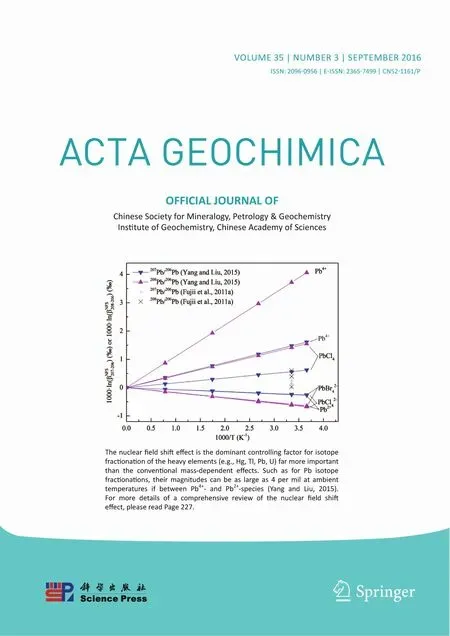Geochemistry of Tertiary sandstones from southwest Sarawak,Malaysia:implications for provenance and tectonic setting
2016-08-26NasimFerdousAtikulHaqueFarazi
Nasim Ferdous·Atikul Haque Farazi
Geochemistry of Tertiary sandstones from southwest Sarawak,Malaysia:implications for provenance and tectonic setting
Nasim Ferdous1·Atikul Haque Farazi1
©Science Press,Institute of Geochemistry,CAS and Springer-Verlag Berlin Heidelberg 2016
Tertiary sandstones collected from southwest Sarawak,Malaysia,were analyzed to decipher their provenance,weathering,and tectonic setting.The studied sandstones have a sublitharenite composition and are dominantly composed quartz with little mica and feldspar,and a small amount of volcanic fragments.These sandstones were generally derived from quartz-rich recycled orogenic sources.They have relatively high SiO2content with low Na2O,CaO,MnO,and MgO contents.Values of Chemical Index of Alteration(CIA)of these rock samples vary from 71 to 93,with an average of 81,implying intense chemical alteration during weathering.A felsic igneous source is suggested by a low concentration of TiO2compared to CIA,enrichment of Light Rare Earth Elements,depletion of Heavy Rare Earth Elements,and negative Eu anomalies.A felsic origin is further supported by a Eu/Eu* range of 0.65-0.85 and high Th/Sc,La/Sc,La/Co,and Th/ Co ratios.This work presents the first reported geochemical data of Tertiary sandstones of the Sarawak Basin.These data led us to conclude that the sandstones were dislodged from recycled orogenic sources and deposited in a slowly subsiding rifted basin in a passive continental tectonic setting.
Geochemistry·Tertiary sandstone·
Provenance·Tectonic setting·SW Sarawak·Malaysia
1 Introduction
Geochemical and petrographic analyses of sedimentary rocks revealtheirmineralogicalcomposition,chemicalcomposition,degree of weathering,and geological evolution of the source area,all of which offer clues to the tectonic setting of the depositionalbasin(Nesbittetal.1980;BhatiaandCrook1986;Roser and Korsch 1986;1988;Dabard 1990;McLennan et al. 1993;Verma and Armstrong-Altrin 2013).The history of evolutionaryprocessesofsedimentaryrocksispreservedinthe rocks'chemical composition.Immobile trace elements,rare earth elements(REEs),and major elements are reliable indicators in the evaluation of tectonic setting,weathering processes,andprovenance(Nesbittetal.1980;NesbittandYoung 1982;Bhatia 1983;1985;Taylor and McLennan 1985;Bhatia and Crook 1986;Roser and Korsch 1986;1988;Dabard 1990;McLennan et al.1993;Crichton and Condie 1993;Verma and Armstrong-Altrin 2013).Tectonic setting has strong compositional control over sedimentary rocks.Passive margin sediments are characterized by felsic composition whereas active margin or arc sediments are typically enriched in mafic components(Bhatia and Crook 1986;McLennan et al.1993).
Several major element parameters and ratios,including Fe2O3+MgO,TiO2,Al2O3/SiO2,Al2O3/(CaO+Na2O),and K2O/Na2O,are used for studying provenance and tectonic setting(Bhatia 1983;Roser and Korsch 1986).Bhatia (1983)usedmajorelementconcentrationfunctionstocreatea discrimination diagram for differentiating tectonic settings:oceanic island arc(A),continental island arc(B),active continental margin(C),and passive margin(D).Also using major element concentrations,Roser and Korsch(1986)presented a classification scheme of three main tectonic settings:passive margin(PM),active continental margin (ACM),and oceanic island arc(ARC).Trace elements(including REEs)play a significant role in provenance study.Their low mobility relative to sedimentary processes and short residence time in seawater allow them to preserve the primordialgeochemistryoftheirsourcerockstoalargeextent (Bhatia and Crook 1986;McLennan et al.1993).Degree of weathering in the source area can be estimated by using the ChemicalIndexofAlteration(CIA)andTh/U,Th/Sc,andZr/ Sc ratios(Nesbitt and Young 1982;McLennan et al.1993).
Although a number of models of tectonic setting of the Sarawak Basin have been proposed(Holloway 1982;James 1984;Tan and Lamy 1990;Hutchison 1996;Mat-Zin1996),none of them could make irrefutable conclusions about the tectonic setting of the area.On the basis of plate tectonic theory,a tectonic framework for northwest Borneo was first proposedbyJames(1984).AccordingtoJames,theSarawak Basin was developed as a result of subduction of oceanic crust of the South China Sea beneath continental crust of northwest Sarawak.Later findings supported this model (Tan and Lamy 1990;Hutchison 1996).Tectonic evolution of northwest Borneo commenced in the Late Cretaceous withinitiationofsimultaneousriftingoftheSouthChinaSea Basin.The pre-existing South China Sea oceanic crust subductedsouthwestwardbeneaththeSundashelfduringthe Paleocene to Late Eocene.The subduction front is marked by the Lupar line(Tan and Lamy 1990).This line also represents the southwest limit of the subducting oceanic crust. This subduction was most probably terminated during Paleocene time(Holloway 1982)and evolved into collision during Eocene time.This is evidenced by the compressed Rajang Group-of Eocene age-between the Schwaner Mountain Zone and the Luconia-Balingian-Miri block.The Schwaner Mountains represent a subduction-related Lowerto-UpperCretaceousvolcano-plutonicarc(Hutchison 1996).The gap between the Schwaner Mountains and the accretionary prism is considered by some to be a fore-arc basin(Moss 1998).However,a prior study(Mat-Zin 1996)had hypothesized that the Tertiary tectonic history of the Sarawak Basin is characterized by strike-slip faulting.The fore-arc basin hypothesis suffers from the absence of an exposed trench,lack of preserved volcanic rocks,and not having age data for the Luconia sediments(Mat-Zin 1996).
The main objective of this study was to gain insight into the provenance,tectonic setting,and source area weathering of the Tertiary sandstones of southwest Sarawak.To this end,sandstone samples were collected from three different formations:the Plateau Sandstone,the Kayan Sandstone,and the Silantek Formation.
2 Geologic background
The study area is comprised of northwestern Borneo,southwestern Sarawak,and the Kuching Zone located at the western part of the Lupar valley(Fig.1).It covers an area of about 100 km2and is a part of the Sundaland,composed of continental crust.Haile(1974)subdivided Borneo into the West Borneo Basement,the Kuching Zone(bounded by the Lupar line),the Sibu Zone,and the Miri Zone.Borneo is believed to have formed during Mesozoic time as the result of the accretion of several micro-continental blocks that originated from the then South China and Australian Gondwanaplates(HallandNichols2002;Metcalfe2011).In Jurassic time,however,the Borneo continental block rifted and separated from the Australian plate.During the Late Cretaceous,the block drifted northward and accreted to southeast Sundaland.The opening and later spreading of the South China Sea led to the separation of several small continental plates from the South China or Indochina block,which then drifted southward by Cretaceous time(Hall and Nichols 2002;Metcalfe 2011).Paleomagnetic data show that Borneo began to rotate anti-clockwise in the Late Oligocene.The movement ended in the Middle Miocene when the block arrived at its present-day orientation(Hall 2002;Hutchison 2005).
The Rajang group was uplifted and amalgamated along the Lupar line during the Late Eocene to Early Oligocene (Hutchison 2005).The Kuching Zone consists of an exposed basement complex,shelf deposits,molasse,and related sediments(Haile 1974).The Kerait Schist is the oldest formation outcropping as basement,and is conformably overlain by the Tuang Formation(Fig.2).The Terbat Formation unconformably overlies the Tuang Formation and underlies the Serian volcanics.The Sadong Formation unconformably overlies the Serian volcanics. This formation,in turn,is unconformably overlain by the Kedadom and Bau Formations of Upper Jurassic age,and also by the Pedawan Formation of Lower Cretaceous age (Hutchison 2005).The Pedawan Formation is unconformably overlain by the Kayan Sandstone.In the Simunjan area,the Eocene Silantek Formation is equivalent to the Kayan Sandstone,which is unconformably overlain by the Plateau Sandstone(Hutchison 2005).Previous studies established two major igneous events in the study area,described as extensional imprints.The first happened during Cretaceous time(known as the Cretaceous intrusive)and the other occurred during Miocene time(‘‘Sintag intrusives'').
The Cretaceous rocks are predominantly acidic and are composed of granites,while intrusions in the extensional zones are hybridized gabbros.The granitoids of the Lundu area have yielded a K-Ar date of Cretaceous age (78±5 Ma)(Hutchison 2005).The Sintag intrusives in the Kuching Zone consist of hundreds of small‘‘post-basement intrusions''(Williams and Harahap 1987;Hutchison 2005). Williams and Harahap(1987)attributed this magmatic activitytodeepcrustalre-melting.Theyalsostatedthatthese intrusions commenced in a passive post-subductionalsetting.As a consequence of partial melting,the Lower Miocene diorite and Middle-Upper Miocene dacite were derived from island arc basaltic magma and subducted oceanic crust,respectively(Prouteau et al.2001).
To conduct this study,nineteen sandstone samples were collected from the Plateau Sandstone,the Kayan Sandstone,and the Silantek Formation.The Kayan Sandstone in the Lundun-Kuching area is Upper Paleocene to Mid-Miocene in age.It is composed predominantly of massive and crossbedded sandstone and conglomerate along with thin beds of black,red,and grey mudstone(Wilford 1955).Tan(1984)described this formation as fluvial to deltaic environment deposits.The Silantek Formation in the Kuching-Simunjan area is of Upper Eocene to Oligocene age and is predominantly composed of thick-bedded sandstone interbedded with subordinate silty shale and mudstone in the lower part. On the other hand,the middle part consists of lenticular sandstone,which has interbeds of siltstone,silty shale,and mudstone.Again,the upper part of this formation is predominantlycomposedofredmicaceousmudstone,shale,red siltstone,and sandstone(Hutchison 2005).These sediments are overlain by thick-bedded massive and cross-bedded sandstone with grey-to-red mudstone(Tan 1979).The depositional environment is near-shore and estuarine at the base then becomes fluvial-lacustrine upward(Hutchison 2005).ThePlateauSandstoneoftheKuchingareaislikelyof Upper Eocene to Lower Oligocene age,and consists of thick-bedded massive and cross-bedded sandstone with grey-to-red mudstone and conglomerate(Tan 1979).Its depositional environment varies between fluvial and estuarine(Hutchison 2005).
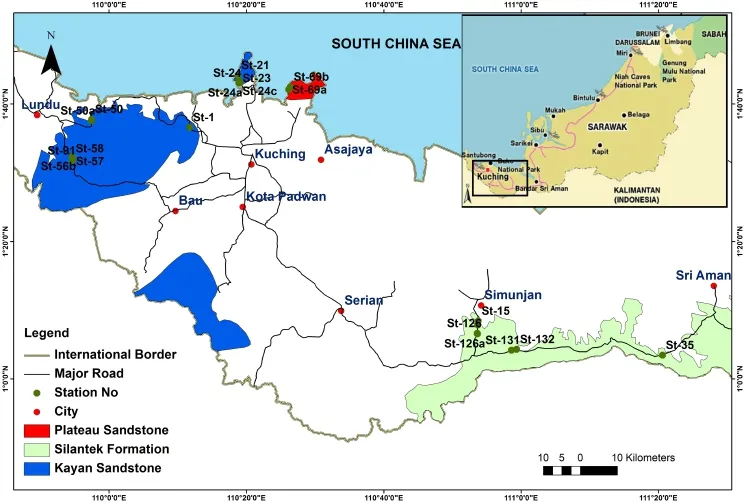
Fig.1 Location map of the study area(modified from Tate 2001)
3 Methods
Geochemical and petrographic analyses were carried out to disclose provenance and tectonic setting of the studied sandstones.Representative samples were collected from the Kuching,Lundu,and Simunjan areas(Fig.1).Eight samples were collected from the Kuching area;among them,six were from the Kayan Sandstone(St-1,St-23,St-24,St-24a,St-24b,and St-24c)and two were from the Plateau Sandstone(St-69a and St-69b).Four samples from the Kayan Sandstone Formation(St-50,St-56a,St-56b,and St-57)and seven samples from the Silantek Formation(St-15,St-35,St-126,St-126a,St-129,St-131,and St-132)were collected from the Lundun and Simunjan areas,respectively.Apart from these,we analyzed seven thin sections(n=7)of the Tertiary sandstones of southwest Sarawak with a petrographic microscope.We carried out 300 counts per thin section using the Gazzi-Dickenson point counting method(Ingersoll et al.1984).Whole rock geochemical analyses of nineteen sandstone samples (n=19)of Tertiary age were conducted to obtain their major and trace element(including REE)geochemistry. The samples were analyzed by lithium metaborate/tetraborate fusion Inductively Coupled Plasma(ICP)and ICP Mass Spectrometry(ICP-MS).The geochemical analyses wereperformedatActivationLaboratoriesLimited,Canada.Rock samples were pulverized prior to analysis. There is a possibility that up to 0.2%Fe contaminant was added during pulverization by mild steel.
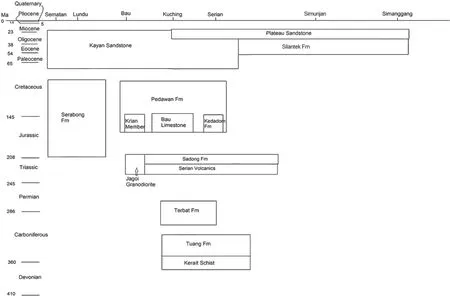
Fig.2 The stratigraphy of the study area(modified from Hutchison 2005)
4 Results and analyses
4.1Petrography
Our petrographic study revealed that the Tertiary sandstones are predominantly composed of quartz grains,which were found to comprise 62%-80%of framework minerals(with an average of 74%).The quartz constituents are sub-angular to sub-rounded in shape.Both mono-and polycrystalline quartz were identified.Other noted content included lithic grains,feldspar,and mica.Lithic grains were the second most dominant component of the sandstones,making up 16%-21%of the rock volume.Identified grains were primarily of sedimentary or metasedimentary(mainly chert)origin;sparse volcanic rock fragments were also observed.Feldspar content ranged from 0.9%to 8.2%,with plagioclase being the prominent feldspar.Micaceous minerals-muscovite(up to 3.3%)and biotite(up to 1.3%)-represented about 5%of the total framework grains.Other than these,negligible amounts of carbonates were found in most of the samples with the exception of sample St-57,which was found to be rich in calcite grains and cement.
The characteristics of the framework grains of the Tertiary sandstones,i.e.,prevalence of quartz,presence of a certain amount of sedimentary and/or meta-sedimentary lithics along with feldspar,and minor abundance of volcanic fragments(Fig.3a),put them in the sublitharenitic category.In the QFL diagram of Dickinson et al.(1983),the sublitharenite sandstones fall in the field of recycledorogenic terrain/provenance(Dickinson and Suczek 1979;Dickinson et al.1983)(Fig.3b).
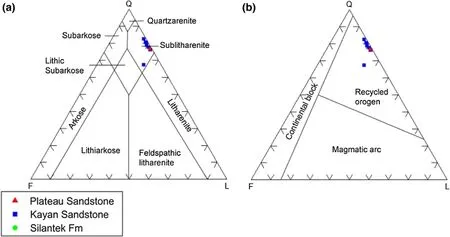
Fig.3 QFL diagram for Tertiary sandstones of SW Sarawak(provenance fields after Dickinson et al.1983)
4.2Geochemistry
Major and trace element composition of sediments is a good indicator of tectonic setting and provenance.Results of whole-rock geochemical analysis of the studied sandstones of the southwest Sarawak basin are presented in Table 1.
SiO2content of sandstones of the southwest Sarawak basin was found to be high(ranging from 76%to 95%,with an average 87%).Average concentrations of other prominent oxides were 7%for Al2O3,1.2%for Fe2O3,1.4%for K2O,0.3%for TiO2,and 0.2%for Na2O. Lower concentrations were detected for CaO,MnO,MgO,and P2O5(0.04%,0.007%,0.2%,and 0.02%respectively).Harker Diagrams show variation in the major elements of sandstone relative to SiO2(Bhatia 1983;Roser and Korsch 1988).Plots of TiO2,Al2O3,Fe2O3,K2O,Na2O,CaO,MnO,and MgO against SiO2concentration show negative linear patterns(with R2values 0.697,0.935,0.643,0.839,0.456,0.142,0.496,and 0.727,respectively)(Fig.4).Analyses of Na2O,CaO,MnO,and MgO returned very low concentrations with increasing SiO2while Al2O3,Fe2O3,and K2O returned relatively high values.
SiO2content is an indicator of abundance of all silicate minerals present in the sandstone with quartz obviously acting as the prominent function in this representation.The observed relative enrichment in Al2O3and K2O is related to elevated levels of mica,K-feldspar,and clay minerals. Depletion of Na2O and CaO is attributed to lower abundance of feldspar.The lower feldspar levels are probably a consequence either of weathering processes or of the source area being depleted in feldspar(Bhatia 1983;Dabard 1990;Crichton and Condie 1993).High SiO2/ Al2O3ratios and low Na2O/K2O ratios are signs of mature sandstones(Dabard 1990).The ranges of SiO2/Al2O3and Na2O/K2O values from 6.8 to 35.2 and 0.02 to 0.38,respectively,suggest that the studied sandstones represent relatively mature sediments.According to Crook(1974),K2O/Na2O ratios predict the level of quartz in sandstone (Fig.5a).Geochemically,the studied Tertiary sandstones show large variation in composition,and are classified as arkose,subarkose,litharenite,and sublitharenite(Herron 1988)(Fig.5b).Variation of major elements is probably a result of sedimentary processes(Bhatia 1983).
Sandstones of the study area show moderate-to-little variation in concentration of trace elements.This characteristic signifies shared provenance,weathering,and tectonic setting(Bhatia 1983;Bhatia and Crook 1986;Crichton and Condie 1993).Positive correlation of Al,Cs,Ba,Th,and U with K content implies that concentrations of these elements are controlled by clay and mica contents. Moreover,Zr/Sc and Zr/Hf ratios act as good indicators to monitor zircon enrichment(Crichton and Condie 1993;McLennan et al.1993).In these samples,the high Zr/Hf (range of 35-46.with an average of 41)and Zr/Sc(range from 22 to 62)ratios are manifestations of zircon enrichment.Furthermore,positive correlation between Ba and K2O suggests association of Ba with feldspar.La/Sc ratio also implies of rock maturity,generally varies from 3 to 9(Bhatia and Crook 1986;Dabard 1990).Studied sandstones show large variation in La/Sc ratio,which ranges from 2.75 to 14.5(Table 2).V and Sc tend to be associated with mafic content.Lower V and Sc contents in the samples suggest that these sandstones were derived from V-and Scdepleted source rocks(Bhatia 1983;1985;Bhatia and Crook 1986;Dabard 1990).
Chondrite-normalizeddiagramsillustrateREEpatternsin the studied samples(Fig.6a).Generally,total REE concentrations in these sandstones ranged from 21 to 309 ppm (Table 1).These samples exhibited light REE(LREE)enrichment,flat heavy REE(HREE)patterns,and negative Eu anomalies.The average REE concentrations of all samples were compared to the Post-Archean average Australian Shale(PAAS)and the Upper Continental Crust(UCC)concentration values(Fig.6b)(Taylor and McLennan 1985).

Table 1 continued
5 Discussion
5.1Provenance and weathering
Abundance of REEs in sedimentary rock is an indicator of the source area.REE patterns reflect the characteristics of source rocks,from which sediments are derived and accumulate in the basin.Sediments deriving from a common source do not show any noticeable fluctuation in their REE patterns.On the other hand,REEs show variable patterns in sediments that originated from heterogeneous source rocks (NanceandTaylor1976;1977;TaylorandMcLennan1985; Cullers1994;1995).Notably,felsicrocksgenerallyexhibita high LREE/HREE ratio with negative Eu anomalies,whereas mafic and/or ultramafic rocks have low LREE/ HREE ratios with no orpositive Eu anomalies.Inthe case of Eu,Eu3+behavesasanincompatibleelementinanoxidizing magma,whereas Eu2+substitutes for Ca2+in plagioclase (Taylor and McLennan 1985).In Fig.6a,b,the studied sandstones tend to have LREE enrichment and flat HREE patterns with negative Eu anomalies.Their average REE concentration shows a pattern similar to PAAS and UCC. Enrichment of LREEs and simultaneous low HREE values withnegativeEuanomaliesareindicativeofafelsicigneous source(Taylor and McLennan 1985).Additionally,Eu/Eu* values in these samples ranged from 0.65 to 0.85,with an average of 0.72.This characteristic is also suggestive of a felsicsource(NanceandTaylor1977;TaylorandMcLennan 1985;McLennan et al.1993;Cullers 1994;1995).Ratios of Eu/Eu*,(La/Lu)cn,Th/Sc,La/Sc,La/Co,and Th/Co offer clues about source including whether the source is felsic or mafic(Cullersetal.1988;Cullers1994;2000)(Table 2).All of the observed ratios indicate without any ambiguity that these Tertiary sediments of the southwest Sarawak derived from felsic source rock.
As a consequence of their immobile characteristic,trace elements in sediments reflect source rock composition.Zr,Nb,Hf,and Y are high field strength elements,which are preferentially partitioned into melts during crystallization. This mechanism results in these elements being enriched in felsic rather than mafic sources.In contrast,Co,Sc,and V are more concentrated in mafic than in felsic source rocks (Taylor and McLennan 1985;Feng and Kerrich 1990).

Fig.4 Harker variation diagrams for major elements in the SW Sarawak sandstones
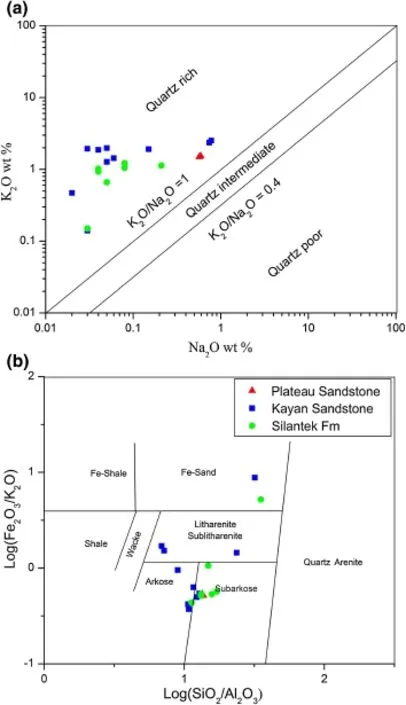
Fig.5 a Richness of quartz of the analyzed sandstones(after Crook 1974)and b Chemical classification of the analyzed sandstones(after Herron 1988)
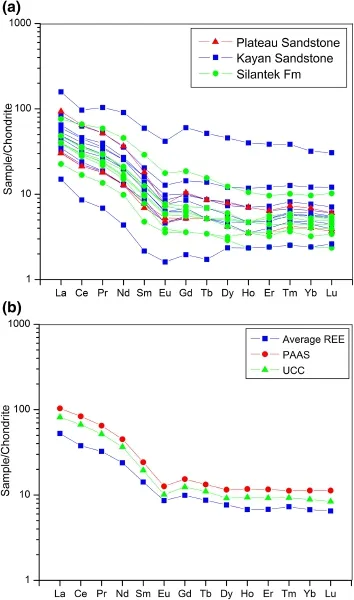
Fig.6 Chondrite-normalized rare earth element plots of the analyzed sandstones(Chondrite normalization values from Taylor and McLennan 1985)

Table 2 Elemental ratios of the Tertiary sandstones compared with sediments derived from felsic,mafic rocks and the upper continental crust
Roser and Korsch(1988)proposed a technique to differentiate sediment provenance based on major element concentration.There are four categories of provenance:mafic and less-intermediate igneous(P1),intermediate igneous(P2),felsic igneous(P3),and quartzose sediments of mature continental provenance(P4).The studied sandstones fall in the P4 field(Fig.7).The sediments could be derived from relatively highly weathered granitic gneissic terrain and/or pre-existing sedimentary terrain(Roser and Korsch 1988).
Weathering that took place in the hinterland is measured as CIA.Concentrations of alkali and alkaline earth elements change during weathering with chemical alteration (Nesbitt et al.1980;Nesbitt and Young 1982).CIA is calculated using molecular proportions:

where CaO*resides in the silicate fraction(CaO*= CaO-10/3(P2O5))(McLennan et al.1993).Low CIA values indicate a lack of weathering whereas high values indicate a highly chemically weathered source area(Rahman and Suzuki 2007;Nesbitt and Young 1982).
In the A-CN-K diagram,values of the samples fall near the Al2O3corner,far from the line joining plagioclase and K-feldspar(Fig.8).The samples'CIA values vary from 71 to 93.The average CIA value(81)of the sandstones of the southwest Sarawak is considerably higher than the upper continental crust value(50).The CIA range of values (71-93)indicates that chemical alteration played a major role during weathering,or alternatively during sedimentary recycling(Nesbitt et al.1980;Nesbitt and Young 1982;McLennan et al.1993).The negative correlation between CIA and K2O/Al2O3suggests that K-bearing minerals belong to the clay fraction.
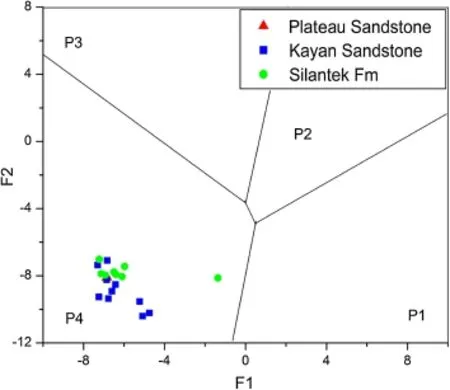
Fig.7 Plot of discriminant function F1 and F2 for the analyzed sandstones(after Roser and Korsch 1988)
TiO2tends to be enriched in strongly weathered soils due to its low solubility.However,our analysis shows that TiO2concentration decreases with increasing CIA.This suggests that these sediments originated from a TiO2depleted source-felsic source rocks.(Bauluz et al.2000).
The Th/U ratio varies from 3.5 to 4.0 for most upper crust rocks.Enrichment of U is commonly found in anoxic sediments.During weathering and sedimentary recycling under oxidizing conditions,insoluble U4+ions are converted into soluble U6+ions.Higher Th/U values are indicative of dissolution and loss of U during sedimentation(Taylor and McLennan 1985;McLennan et al.1993).Low Th/U ratios indicatetheenrichmentofUinthesediments.Insedimentary rocks,Thdispersesasatraceelementinheavyminerals(e.g. zircon and monazite).U is not abundant in coarse-grained inorganic sedimentary rocks(e.g.quartzite and arkose);the range generally is from 0.5 to 1.5 ppm but can increase with increasingclayminerals(Mielke1979).TheTh/Uratioisan important index for monitoring kaolinite content,which increases with elevated Th/U values.The Th/U ratio in the study area ranges from 2.8 to 4.9 with an average of 3.83. These values suggest that the sediments were affected by weathering and sedimentary recycling.A Th/U versus Th plot shows a normal weathering trend(Fig.9a).
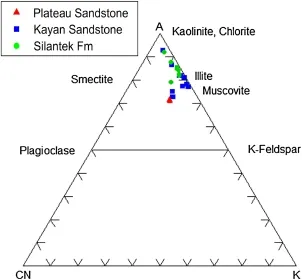
Fig.8 CIA ternary diagram of analyzed sandstones(after Nesbitt and Young 1982)
A Th/Sc vs Zr/Sc plot is another indicator of weathering andsedimentaryrecycling(McLennanetal.1993)(Fig.9b).In this plot the Zr/Sc ratio shows a substantial increasing trend with enrichment of zircon,whereas the increase is very low for Th/Sc.High Th/Sc and Zr/Sc ratios represent compositional variation and sediment recycling (zircon addition),respectively.This plot reflects a general trend for analyzed sandstones derived from igneous sourcerocks through intensive weathering(Rahman and Suzuki 2007;McLennan et al.1993).Enrichment of incompatible Th and Zr,over compatible Sc is an indicator of felsic provenance.
5.2Tectonic setting
Major and trace elements are important indicators for inferring tectonic setting as well as depositional environment of sedimentary rocks.
Verma and Armstrong-Altrin(2013)recommend two discrimination function diagrams for tectonic discrimination of siliciclastic sediments:one for high-silica rocks[(SiO2)adj=63%to95%]andoneforlow-silica[(SiO2)adj=35%to 63%].These discrimination diagrams represent useful binary plots to differentiate among tectonic settings such as island or continental arc(Arc),continental rift(Rift),and collision(Col).According to SiO2content of the studied samples,the tectonic discrimination diagram for high-silica[(SiO2)adj=63%to 95%]has been used.Two discrimination functions(F1 and F2)are calculated based on major element concentrations(Fig.10).The results obtained from discriminant function analysis provide striking evidence of deposition in a rift basin(Fig.10).
La-Th-Sc,Th-Sc-Zr/10,and Th-Co-Zr/10 are important ternary plots for determining tectonic setting although a La-Th-Sc plot cannot discriminate between active and passive continental margins;Th-Co-Zr/10 and Th-Sc-Zr/ 10 can differentiate these settings.These ternary plots can generally discriminate between the following tectonic settings:oceanic island arc(A),continental island arc(B),activecontinentalmargin(C),andpassivemargin (D)(Bhatia 1983;Bhatia and Crook 1986).High La/Sc ratios in the La-Th-Sc plot indicate a continental setting (Fig.11a).The Th-Co-Zr/10 and Th-Sc-Zr/10 diagrams confirm that the studied sandstones belong to a passive margin tectonic setting with high Zr/Th ratios(Fig.11b,c). All these plots reflect sediments with low Sc and Co concentrations,derived from a source depleted in those elements(Bhatia and Crook 1986).
Another discrimination diagram was proposed by Roser andKorsch(1986),usingK2O/Na2OagainstSiO2. Increasing values of K2O/Na2O and SiO2indicate a change from ARC to ACM to PM.High K2O/Na2O and SiO2values indicate a relatively stable or passive margin tectonic environment of deposition for the analyzed Tertiary sandstones(Fig.12).
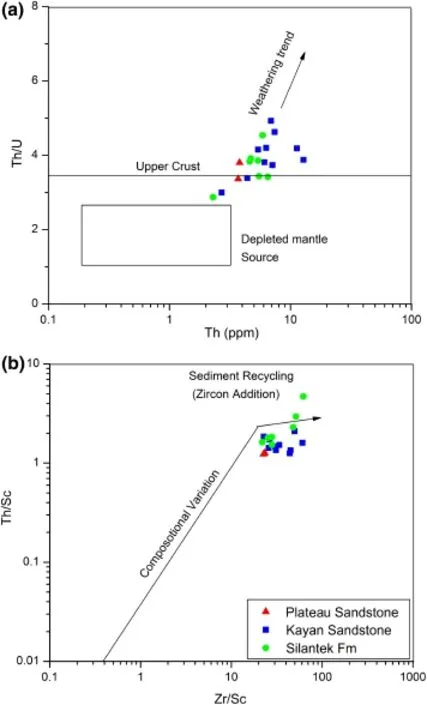
Fig.9 a Plot of Th/U versus Th for the analyzed sandstones and b Plot of Th/Sc vs Zr/Sc for the analyzed sandstones(after McLennan et al.1993)
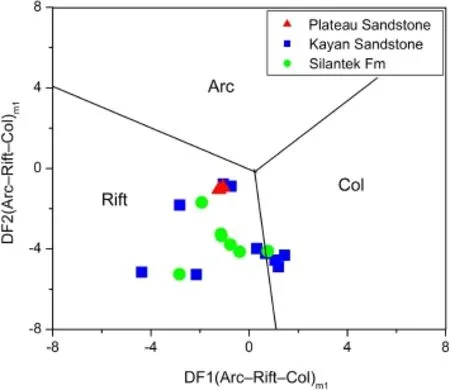
Fig.10 Discriminant-function multi-dimensional diagram for highsilica clastic sediments from three tectonic settings(arc,continental rift,and collision)(after Verma and Armstrong-Altrin 2013)
In the Late Cretaceous,southwest Sarawak was uplifted to form highlands and intermontane basins(Tan 1986). According to paleocurrent studies(Tan 1986;Hutchison 2005),Tertiary sediments of the studied area-derived from the highlands in the Kuching-bau-Serian area-were deposited in those basins.The Kayan Sandstone commenced to deposit during the Early Tertiary.It consists of massive and cross-bedded sandstones and conglomerates,which indicate a fluvial to deltaic depositional environment.The Silantek Formation and the Plateau Sandstone Formation were deposited in deltaic,fluvial,and lacustrine environments starting in the Early Eocene and continuing until the Late Oligocene or possibly Miocene.The overall prevailing Tertiary paleogeographic setting of southwest Sarawak(uplifted highlands providing sediment to fluvial,lacustrine,and deltaic depositional settings)conforms to our findings:sedimentary material from a recycled orogenic source and quartzose sediments of mature continental provenance were deposited in a passive tectonic setting,experiencing weathering and recycling processes while transported by rivers.

Fig.12 Tectonic-setting diagram of the analyzed sandstones(after Roser and Korsch 1986)
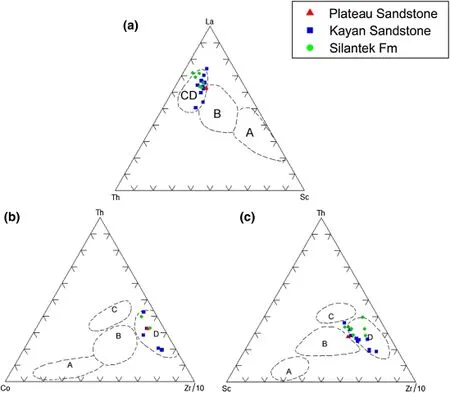
Fig.11 Trace element Ternary plots for tectonic setting discrimination(after Bhatia and Crook 1986)
Petrographic study of the Kayan sandstones divulged that they are sublitharenitic in composition,containing mainly subangular to subrounded quartz grains,plagioclase feldspar,rock fragments,and small amount of carbonates in their framework.At the same time,it is evident from geochemical plots of these samples that a number of them haveverystrongsubarkosicaffinity(Fig.5b).This anomalous geochemical behavior is perhaps the result of the existence of the feldspars and rock fragments.Such ambiguity in the classification of the samples and their overall composition suggests that they were deposited in aquiescent period of slow subsidence.The subsidence was the result of mechanical creation of accommodation space due to gradual sediment loading in a rifted basin.The then prevailing river systems carried these matured sands from the uplifted hinterland area into the rifted basin;contemporaneously,the relatively immature subarkosic sandsproducts of rifting-were mixed with them.This explanation is consistent with the phenomenon of large variation in REE patterns in the spider diagrams(Fig.6a)and our plot of the Verma and Armstrong-Altrin(2013)diagram (Fig.10).
6 Conclusions
Provenance of the Tertiary sandstones of three typical formations of southwest Sarawak-the Kayan Sandstone,the Silantek Formation,and the Plateau Sandstone,which range in age from Paleocene to Miocene-were determined by whole rock geochemical analytical methods.Moreover,petrographic studies were conducted to corroborate the findings from the geochemical analyses.Our conclusion is that these sandstones were derived primarily from felsic continental sources and underwent significant weathering and recycling processes due to orogenic activities,and that these sediments were deposited in a slowly subsiding intracontinental rifted basin of passive tectonic setting. These findings help unravel the complex tectonic history of the southwest Sarawak Basin.
AcknowledgmentsComments from reviewers and WANG Binbin were very helpful and valuable.The financial support from the project (PPP)PG003-2013A of the University of Malaya,Kuala Lumpur,Malaysia in carrying out this research work is gratefully acknowledged.Partial support from the project RP002C-13AFR of the University of Malaya is also gratefully acknowledged.Our thanks to M.K.Iskandar for supporting the field work.The facilities provided by the Department of Geology,University of Malaya are thankfully acknowledged.
References
Bauluz B,Mayayo MJ,Fernandez-Nieto C,Gonzalez-Lopez JM (2000)Geochemistry of Precambrian and Paleozoic siliciclastic rocks from the Iberian Range(NE Spain):implications for source area weathering,sorting,provenace,and tectonic setting. Chem Geol 168:135-150
Bhatia MR(1983)Plate tectonics and geochemical composition of sandstones.J Geol 91:611-627
Bhatia MR(1985)Rare earth element geochemistry of Australian Paleozoic graywackes and mudrocks:provenance and tectonic control.Sed Geol 45:97-113
Bhatia MR,Crook KAW (1986)Trace element characteristics of greywackes and tectonic setting discrimination of sedimentary basin.Contrib Miner Petrol 92:181-193
Crichton JG,Condie KC(1993)Trace elements as source indicators in cratonic sediments:a case of study from the early Proterozoic LibbyCreekGroup,southwesternWyoming.JGeol 101:319-322
Crook KAW (1974)Lithogenesis and geotectonics:the significance of compositional variation in flysch arenites(grawckes).Soc Econ Paleontol Min Special Publication 19:304-310
CullersRL(1994)Thecontrolsonthemajorandtraceelementvariation ofshales,siltstones,andsandstonesofPennsylvanian-Permianage fromuplifted continental blocksinColoradotoplatformsediment in Kansas,USA.Geochim Cosmochim Acta 58:4955-4972
Cullers RL(1995)The controls on the major-and trace-element evolution of shales,siltstones and sandstones of Ordovician to tertiary are in the Wet Mountains region,Colorado,U.S.A. Chem Geol 123:107-131
Cullers RL(2000)The geochemistry of shales,siltstones and sandstones of Pennsylvanian-Permian age,Colorado,USA:implications for provenance and metamorphic studies.Lithos 51:181-203
Cullers RL,Chaudhuri S,Kilbane N,Koch R(1979)Rare-earths in size fractions and sedimentary rocks of Pennsylvanian-Permian age from the mid-continent of the U.S.A.Geochim Cosmochim Acta 43:1285-1301
Cullers RL,Basu A,Suttner L(1988)Geochemical signatureof provenance in sand-size material in soils and stream sedimentsnear the Tobacco Root batholith,Montana,USA.Chem Geol 70:335-348
Dabard MP(1990)Lower Brioverian formations(Upper Proterozoic)of the Armorican Massif(France):geodynamic evolution of source areas revealed by sandstone petrography and geochemistry.Sed Geol 69:45-58
Dickinson WR,Suczek CA(1979)Plate tectonics and sandstone compositions.Am Assoc Pet Geol Bull 63:2164-2182
Dickinson WR,Beard LS,Brakenridge GR,Erjavec JL,Ferguson RC,Inman KF,Knepp RA,Lindberg FA,Ryberg PT(1983)Provenance of North American Phanerozoic sandstones in relation to tectonic setting.Geol Soc Am Bull 94:222-235
Feng R,Kerrich R (1990)Geochemistry of fine-grained clastic sediments in the Archean Abitibi greenstones belt,Canada:implications for provenance and tectonic setting.Geochim Cosmochim Acta 54:1061-1081
Haile NS(1974)Borneo In:Spencer AM (ed)Mesozoic-cenozoic orogenic belts:data for orogenic studies.Geological Society of London,Special Publication 4:333-347
Hall R(2002)Cenozoic geological and plate tectonic evolution of SE Asia and the SW Pacific:computer-based reconstruction,model and animations.J Asian Earth Sci 20:353-431
Hall R,Nichols G(2002)Cenozoic sedimentation and tectonics in Borneo:climatic influence on orogenesis.Geol Soc Lond,Special Publication 191:5-22
Herron MM(1988)Geochemical classifi cation of terrigenous sands and shales from core or log data.J Sediment Petrol 58:820-829
Holloway NH(1982)North Palawan Block,Philippines its relationship to the Asian mainland and role in the evolution of South China Sea.Am Assoc Pet Geol Bull 66:1355-1383
Hutchison CS(1996)The‘Rajang accretionary prism'and‘Lupar Line'problem of Borneo.Geol Soc,London 106:247-261
Hutchison CS(2005)Geology of North-West Borneo:Sarawak,Brunei and Sabah.Elsevier,Amsterdam
Ingersoll RV,Bulard TF,Ford RL,Grimn JP,Pickle JP,Sares SW (1984)The effect of grain size on detrital modes:a test of the Gazzi-Dickinson Point Counting method.J Sediment Petrol 54:103-116
James DMD(1984)The geology and hydrocarbon resources of Negara Brunei Darulsalam.Special publication,Brunei Museum and Brunei Shell Petroleum Company
Mat-Zin IC(1996)Tertiary tectonics and sedimentation history of the Sarawak basin,east Malaysia.Ph.D.Thesis,Durham University
McLennan SM(2001)Relation between the trace element composition of sedimentary rocks and upper continental crust.Geochem Geophys Geosyst.doi:10.1029/2000GC000109
McLennan SM,Hemming S,McDaniel DK,Hanson GN(1993)Geochemical approaches to sedimentation,provenance and tectonics.Geol Soc Am Spec Pap 284:295-303
Metcalfe I(2011)Tectonic framework and Phanerozoic evolution of Sundaland.Gondwana Res 19:3-21
Mielke JE(1979)Composition of the Earth's crust and distribution of the elements.In:Siegel FR(ed)Review of research on modern problems in geochemistry,Paris.International Association for Geochemistryand Cosmochemistry,EarthScienceSeries,16:13-37
Moss SJ(1998)Embaluh Group turbidities in Kalimantan:evolution of the remnant oceanic basin in Borneo during the Late Cretaceous and Paleocene.J Geol Soc,London 155:509-524
Nance WB,Taylor SR(1976)Rare earth element patterns and crustal evolution-I.Australian post-Archean sedimentary rocks.Geochim Cosmochim Acta 40:1539-1551
Nance WB,Taylor SR(1977)Rare earth element pat-terns and crustal evolution-II.Archean sedimentary rocks from Kalgoorlie,Australia.Geochimica et Cosmochimica Acta 41:225-231
Nesbitt HW,Young GM(1982)Early Proterozoic climates and plate motions inferred from major element chemistry of lutites.Nature 299:715-717
Nesbitt HW,Markovics G,Price RC(1980)Chemical processes affectingalkalinesandalkalineearthsduringcontinental weathering.Geochim Cosmochim Acta 44:1659-1666
Prouteau G,Maury RC,Pubellier M,Cotten J,Bellon H(2001)Le magmatisme post-collisionnel du Nord-Ouest de Borneo,produit de la fusion d'un fragment de croute oceanique ancre dans le manteau superieur.Bull Soc Geol Fr 172:319-332
Rahman MJJ,Suzuki S(2007)Geochemistry of sandstones from the Miocene Surma Group,Bengal Basin,Bangladesh:implications for Provenance,tectonic setting and weathering.Geochem J 14:415-428
Roser BP,Korsch RJ(1986)Determination of tectonic setting of sandstone-mudstone suites using SiO2content and K2O/Na2O ratio.J Geol 94:635-650
Roser BP,Korsch RJ(1988)Provenance signatures of sandstonemudstone suites determined using discriminant function analysis of major-element data.Chem Geol 67:119-139
Tan DNK(1979)Lupar valley,west Sarawak,Malaysia.Geological Survey of Malaysia,Report 13
Tan DNK(1984)Paleocurrents in the Tertiary sedimentary deposits in western Sarawak.Bull Geol Soc Malaysia 17:257-264
Tan DNK(1986)Palaeogeographic development of west Sarawak. Bull Geol Soc Malaysia 19:39-49
Tan DNK,Lamy JM (1990)Tectonic evolution of the NW Sabah continental margin since the Late Eocene.Bull Geol Soc Malaysia 27:241-260
Tate RB(2001)Geological map of Borneo Island,CD-Rom published by the Geological Society of Malaysia,Kuala Lumpur
Taylor SR,McLennan SM(1985)The continental crust:its composition and evolution.Blackwell,London
Verma SP,Armstrong-Altrin SJ(2013)New multi-dimensional diagrams for tectonic discrimination of siliciclastic sediments and their application to Precambrian basins.Chem Geol 355:117-133
Wilford GE(1955)The geology and mineral resources of the Kuching-Lundu area,west Sarawak including the Bau Mining District.Kuching,Sarawak:Geological Survey Dept.,British Territories in Borneo,Memoir 3
Williams PR,Harahap BH(1987)Preliminary geochemical and age data from post-subduction intrusive rocks,northwest Borneo. Aust J Earth Sci 34:405-415
16 January 2015/Revised:27 December 2015/Accepted:14 February 2016/Published online:29 February 2016
✉ Nasim Ferdous ferdous.nasim1@gmail.com Atikul Haque Farazi reason.farazi.du@gmail.com
1Department of Geology,University of Malaya,Kuala Lumpur 50603,Malaysia
杂志排行
Acta Geochimica的其它文章
- Effects of organic acids on dissolution of Fe and Mn from weathering coal gangue
- Photosynthetic capability and Fe,Mn,Cu,and Zn contents in two Moraceae species under different phosphorus levels
- Effect of pH on binding of pyrene to hydrophobic fractions of dissolved organic matter(DOM)isolated from lake water
- A hydrochemical study of the Hammam Righa geothermal waters in north-central Algeria
- Solubilization of potassium containing minerals by high temperature resistant Streptomyces sp.isolated
- The effects of soil sand contents on characteristics of humic acids along soil profiles
